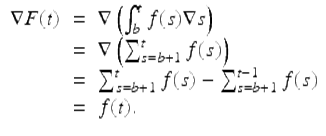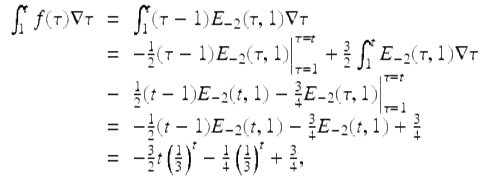Discrete Fractional Calculus (2015)
3. Nabla Fractional Calculus
3.6. Discrete Nabla Integral
In this section we define the nabla definite and indefinite integral, give several of their properties, and present a nabla fundamental theorem of calculus.
Definition 3.31.
Assume ![]() and
and ![]() . Then the nabla integral of f from a to b is defined by
. Then the nabla integral of f from a to b is defined by

with the convention that

Note that even if f had the domain ![]() instead of
instead of ![]() the value of the integral
the value of the integral ![]() does not depend on the value of f at a. Also note if
does not depend on the value of f at a. Also note if ![]() , then
, then ![]() is defined on
is defined on ![]() with F(a) = 0.
with F(a) = 0.
The following theorem gives some important properties of this nabla integral.
Theorem 3.32.
Assume ![]() ,
, ![]() , b ≤ c ≤ d, and
, b ≤ c ≤ d, and ![]() . Then
. Then
(i)
![]()
(ii)
![]()
(iii)
![]()
(iv)
![]()
(v)
![]()
(vi)
if ![]() , for
, for ![]() then ∇F(t) = f(t),
then ∇F(t) = f(t), ![]() ;
;
(vii)
if f(t) ≥ g(t) for ![]() then
then ![]() .
.
Proof.
To see that (vi) holds, assume

Then, for ![]() , we have that
, we have that

Hence property (vi) holds. All the other properties of the nabla integral in this theorem hold since the corresponding properties for the summations hold. □
Definition 3.33.
Assume ![]() . We say
. We say ![]() is a nabla antidifference of f(t) on
is a nabla antidifference of f(t) on ![]() provided
provided
![]()
If ![]() , then if we define F by
, then if we define F by

we have from part (vi) of Theorem 3.32 that ∇F(t) = f(t), for ![]() , that is, F(t) is a nabla antidifference of f(t) on
, that is, F(t) is a nabla antidifference of f(t) on ![]() . Next we show that if
. Next we show that if ![]() , then f(t) has infinitely many antidifferences on
, then f(t) has infinitely many antidifferences on ![]() .
.
Theorem 3.34.
If ![]() and G(t) is a nabla antidifference of f(t) on
and G(t) is a nabla antidifference of f(t) on ![]() , then
, then ![]() , where C is a constant, is a general nabla antidifference of f(t) on
, where C is a constant, is a general nabla antidifference of f(t) on ![]() .
.
Proof.
Assume G(t) is a nabla antidifference of f(t) on ![]() . Let
. Let ![]() ,
, ![]() , where C is a constant. Then
, where C is a constant. Then
![]()
and so, F(t) is a antidifference of f(t) on ![]() .
.
Conversely, assume F(t) is a nabla antidifference of f(t) on ![]() . Then
. Then
![]()
for ![]() . This implies
. This implies ![]() , for
, for ![]() , where C is a constant. Hence
, where C is a constant. Hence
![]()
This completes the proof. □
Definition 3.35.
If ![]() , then the nabla indefinite integral of f is defined by
, then the nabla indefinite integral of f is defined by

where F(t) is a nabla antidifference of f(t) and C is an arbitrary constant.
Since any formula for a nabla derivative gives us a formula for an indefinite integral, we have the following theorem.
Theorem 3.36.
The following hold:
(i)
![]()
(ii)
![]()
(iii)
![]()
(iv)
![]()
(v)
![]()
(vi)
![]()
(vii)
![]()
(viii)
![]()
where C is an arbitrary constant.
Proof.
The formula

is clear when α = 0, and for α ≠ 0 it follows from part (iv) of Theorem 3.1. Parts (ii) and (iii) of this theorem follow from the power rules (3.3) and (3.4), respectively. Part (iv) of this theorem follows from part (iv) of Theorem 3.11. Parts (v) and (vi) of this theorem follow from parts (iv) and (iii) of Theorem 3.16, respectively. Finally, parts (vii) and (viii) of this theorem follow from parts (iv) and (iii) of Theorem 3.19, respectively. □
We now state and prove the fundamental theorem for the nabla calculus.
Theorem 3.37 (Fundamental Theorem of Nabla Calculus).
We assume ![]() and F is any nabla antidifference of f on
and F is any nabla antidifference of f on ![]() . Then
. Then

Proof.
By Theorem 3.32, (vi), we have that G defined by ![]() , for
, for ![]() is a nabla antidifference of f on
is a nabla antidifference of f on ![]() . Since F is a nabla antidifference of f on
. Since F is a nabla antidifference of f on ![]() , it follows from Theorem 3.34 that
, it follows from Theorem 3.34 that ![]() ,
, ![]() for some constant C. Hence,
for some constant C. Hence,
![$$\displaystyle\begin{array}{rcl} F(t)\big\vert _{a}^{b}& =& F(b) - F(a) {}\\ & =& [G(b) + C] - [G(a) + C] {}\\ & =& G(b) - G(a) {}\\ & =& \int _{a}^{b}f(s)\nabla s -\int _{ a}^{a}f(s)\nabla s {}\\ & =& \int _{a}^{b}f(s)\nabla s. {}\\ \end{array}$$](fractional.files/image1828.png)
This completes the proof. □
Example 3.38.
Assume p ≠ 0, 1 is a constant. Use the integration formula

to evaluate the integral ![]() where
where ![]()
![]() . We calculate
. We calculate
![$$\displaystyle\begin{array}{rcl} \int _{0}^{4}(-3)^{-t}\nabla t& =& \int _{ 0}^{4}(1 - 4)^{0-t}\nabla t {}\\ & =& \int _{0}^{4}E_{ 4}(t,0)\nabla t {}\\ & =& \frac{1} {4}E_{4}(t,0)\big\vert _{0}^{4} {}\\ & =& \frac{1} {4}[E_{4}(4,0) - E_{4}(0,0)] {}\\ & =& \frac{1} {4}[(-3)^{-4} - 1] {}\\ & =& -\frac{20} {81}. {}\\ \end{array}$$](fractional.files/image1832.png)
Check this answer by using part (i) in Theorem 3.36.
Using the product rule (part (v) in Theorem 3.1) we can prove the following integration by parts formulas.
Theorem 3.39 (Integration by Parts).
Given two functions ![]() and
and ![]() , b < c, we have the integration by parts formulas:
, b < c, we have the integration by parts formulas:

(3.19)

(3.20)
Example 3.40.
Given ![]() for
for ![]() , evaluate the integral
, evaluate the integral ![]() . Note that
. Note that

To set up to use the integration by parts formula (3.19), set
![]()
It follows that

Hence, using the integration by parts formula (3.19), we get

for ![]() .
.